This article is translated from Bitcoin Magazine's article “THE CONCLUSION OF THE LONG-TERM DEBT CYCLE AND THE RISE OF BITCOIN,” by Dylan Leclair
The conclusion of the long-term debt cycle is an inevitable reality, accompanied by the flourishing development of the Bitcoin network.
In this article, I will detail the reasons why the current global financial system will irreversibly collapse, how it will head towards collapse, and what the world will look like after the current crisis. I will use the framework provided by Ray Dalio in “Principles for Navigating Big Debt Crises” and my own background analysis of the global economic landscape, and I will elaborate on how Bitcoin has developed into a global monetary asset and how it will act as a buffer during crises.
Debt Cycle#
Simply put, debt exists in cycles. When you borrow money today, you increase your purchasing power today, but at the cost of your future purchasing power. If you purchase something you cannot afford now, it means your spending exceeds your output: the money you borrowed comes not only from the lender but also borrows from your future productivity/output. In a credit-based economic system, the expansion and contraction of credit availability lead to economic growth/activity and economic contraction/recession, respectively.
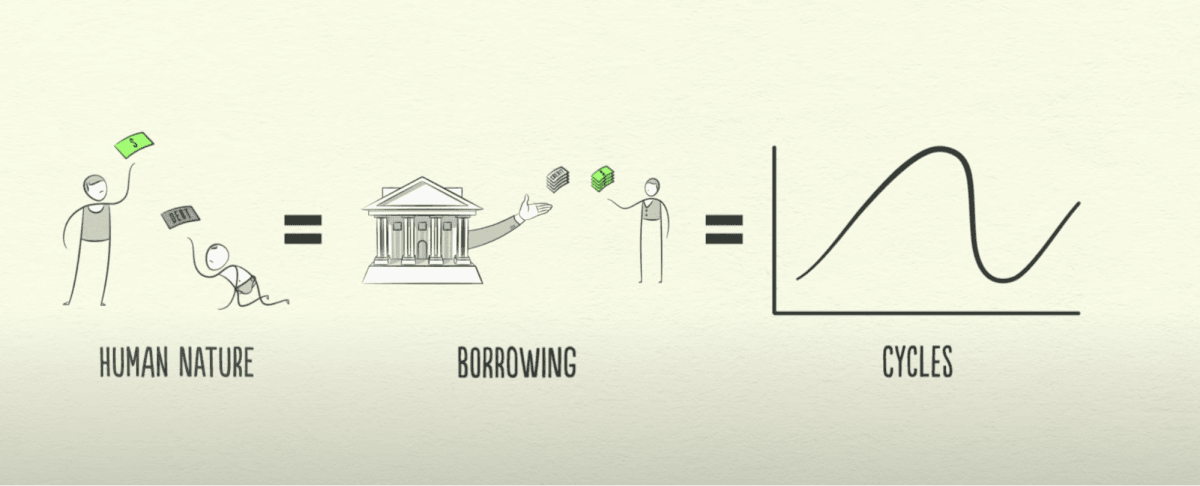
This is true on both personal and macroeconomic levels. When individuals borrow money to consume or invest and fail to achieve positive returns, their future investments/consumption/spending will decrease. This framework also applies to various sectors within the economic system and to the broader economy as a whole.
In the long run, although productivity is the most important aspect of the economic system, the main driving force behind unpredictable economic fluctuations is not productivity but the power of debt/credit.
The Time Value of Money#
To understand the role of debt and credit in the economic system, we need to know the time value of money, which is a very important concept. Simply put, for the same amount of money, any rational economic participant tends to prefer receiving it today rather than waiting for the future. There is an opportunity cost associated with separating from money; if a person chooses to separate from their money, theoretically, the return they receive tomorrow should be positive to compensate for the risk and opportunity cost.
Interaction Between Short-Term and Long-Term Debt Cycles#
While most people are familiar with short-term debt cycles, many are not familiar with the concept of long-term debt cycles, which are much more significant. Why are many people unfamiliar with long-term debt cycles? This is because they rarely repeat, occurring approximately every 75-100 years. Most people will not experience the conclusion of a long-term debt cycle in their lifetime, so they rarely understand its significance.
Below, I will briefly introduce typical short-term and long-term debt cycles and provide some historical context and current statistics to illustrate the current state of the U.S. domestic and global economy.

Short-Term Debt Cycle: Approximately 7-10 Years#
There are many indicators of debt cycles, including the debt-to-income ratio and interest rates. Although the market for capital costs is not completely free in an era where central banks are responsible for regulation, the interest rates set by central banks can serve as a “risk-free rate,” upon which the economic foundation is built. Retrospective analysis shows that by observing the interest rates set by central banks, we can clearly see many cases of short-term debt cycles, often referred to as “boom-bust cycles.”
Long-Term Debt Cycle: Approximately 75-100 Years#
Long-term debt cycles are composed of many short-term debt cycles. The reason for debt crises is that the growth rate of debt and debt servicing costs exceeds the growth rate of income, necessitating deleveraging. To respond to credit tightening, central banks can lower interest rates, thereby reducing relative debt servicing costs while also stimulating the economy. This process repeats during productive investments, and this self-reinforcing credit expansion wave triggers speculative activities and capital misallocation. Ultimately, the debt burden and interest expenses become so large that they are difficult to service, and the central bank's response is to lower interest rates again.
During each cycle, the interest rates at the peak and trough of the cycle are lower than the peak and trough interest rates of the previous cycle. This process continues until the subsequent expansion's strategy of lowering interest rates becomes unsustainable because interest rates reach a lower bound: zero. A zero interest rate marks the beginning of the end of a monetary regime, as it indicates that the overall economic system's debt burden has reached an unsustainable level. If we follow the policymakers' incentive structure and refer to historical precedents, the next logical choice is to sacrifice the value of that currency.
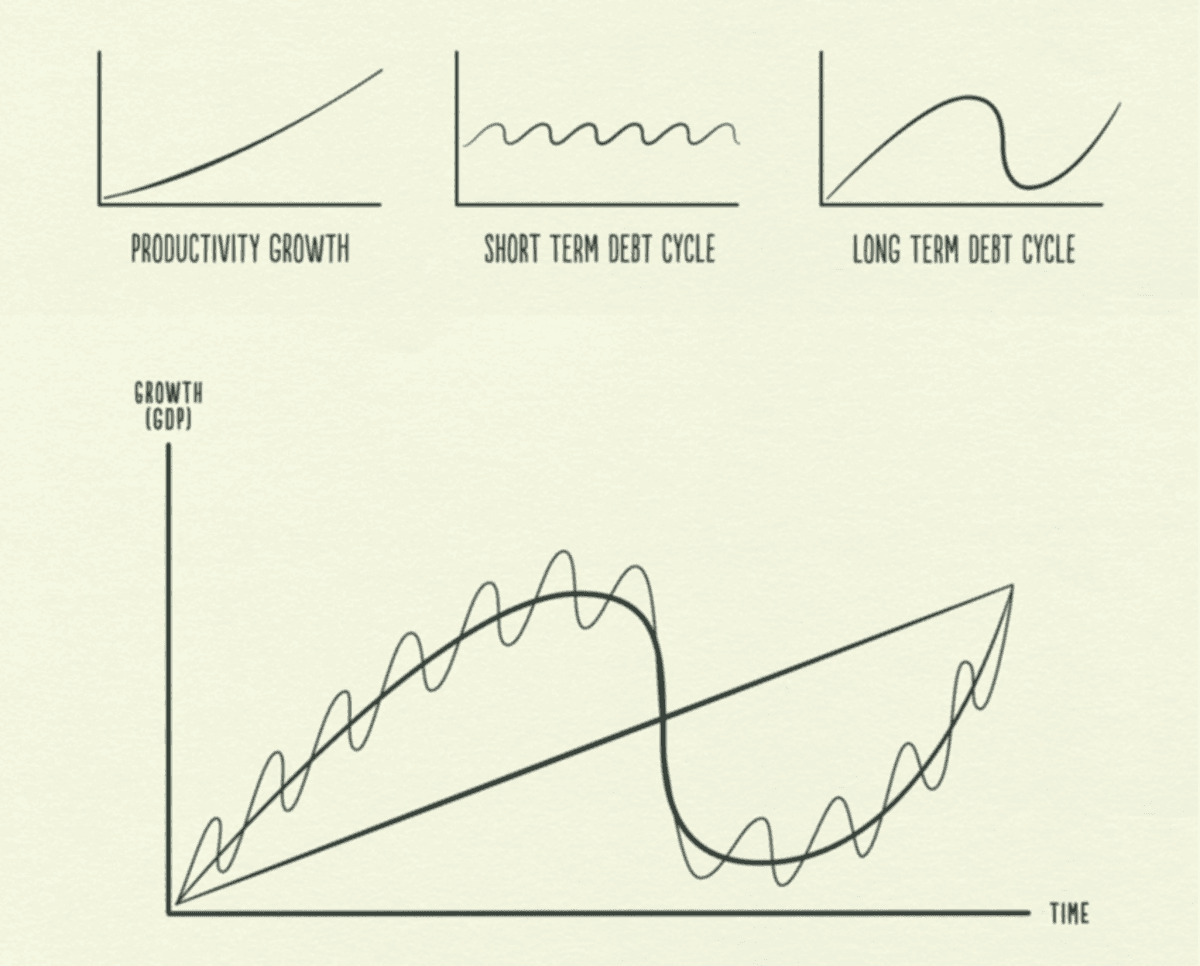
Types of Monetary Policy#
In a deleveraging event, three main forms of monetary policy can be used to alleviate the debt burden. As Dalio defines in “Principles for Navigating Big Debt Crises”:
Monetary Policy 1: Interest Rate-Driven Monetary Policy. This is the central bank's preferred tool and the most effective tool for “stimulating” the economy. This is because lowering interest rates can
- Increase the present value of assets; 2) Make it easier for people to use credit for consumption and investment; 3) Alleviate the debt servicing burden. As long as there is room for interest rates to decline, lowering interest rates is almost always the first response to a debt crisis.
Monetary Policy 2: Quantitative Easing (QE, or “printing money”) to purchase debt securities/financial assets. QE puts cash into the hands of investors, who then seek to reallocate it into other financial instruments. Some economists argue that QE does not create money because this process involves exchanging one financial asset for an equivalent amount of cash. This logic is flawed because the freshly printed money creates demand in the credit market, and without printing money, this demand would not exist.
QE positively impacts investors and asset values but provides little benefit to those without assets. Often (including today), this significantly increases wealth inequality. The more QE is used, the less effective it becomes. QE is most effective when financial markets lack liquidity, but once the credit market has been sufficiently inflated multiple times, the effectiveness of QE diminishes with each marginal currency printed.
Monetary Policy 3: “Cash Vouchers.” This policy form directly puts money into the hands of the public. An example of Monetary Policy 3 is Universal Basic Income and stimulus checks, which have begun to gain popularity and support. The reason for using this form of monetary policy is that the first two forms disproportionately benefit the investment class, while the middle class and lower strata struggle to escape their predicaments. In the later stages of the debt cycle, when wealth inequality reaches its peak and the public begins to seek any possible way to “make money,” the political acceptability of this type of monetary policy becomes highest.
This monetary policy also has another form, which is the monetization of fiscal spending on debt financing by central banks, commonly referred to as “Modern Monetary Theory (Modern Monetary Theory).”
A Brief History of Money#
The Nixon Shock in 1971 (Nixon Shock) triggered a massive change in the dollar and the global monetary order. Before this, other countries had agreed to peg their currencies to the dollar, and global central banks could exchange dollars for gold. However, Nixon decided to “temporarily” close the gold window in August 1971, forever changing the global monetary order. Shortly after this decision took effect, in March 1973, the currencies of G10 countries abandoned the fixed exchange rate standard and began adopting openly floating exchange rates.
For the first time in history, almost the entire world (with the development and interconnection of the global economy) had freely floating currencies (i.e., pure fiat money). The result was a very interesting dynamic environment: countries increasingly tended to competitively devalue their currencies (which lowers their domestic capital costs) to attract foreign capital inflows and promote export markets.
If a country maintains its currency's purchasing power and does not devalue alongside the fiat currencies of other countries, that country's purchasing power will significantly increase, but its domestic manufacturing base and competitiveness in international trade will significantly decline.
Although the Federal Reserve's dollar and monetary policy decisions are made for the U.S. domestic context, policymakers' decisions are not made in a vacuum; they are influenced by the dollar's role as the global reserve currency in the international economy.
What Will the End Look Like?#
It is clear that we are currently in the final stages of a debt supercycle that has lasted over 80 years. We stand at the endpoint of the current monetary order, and we need something new to fill the void.
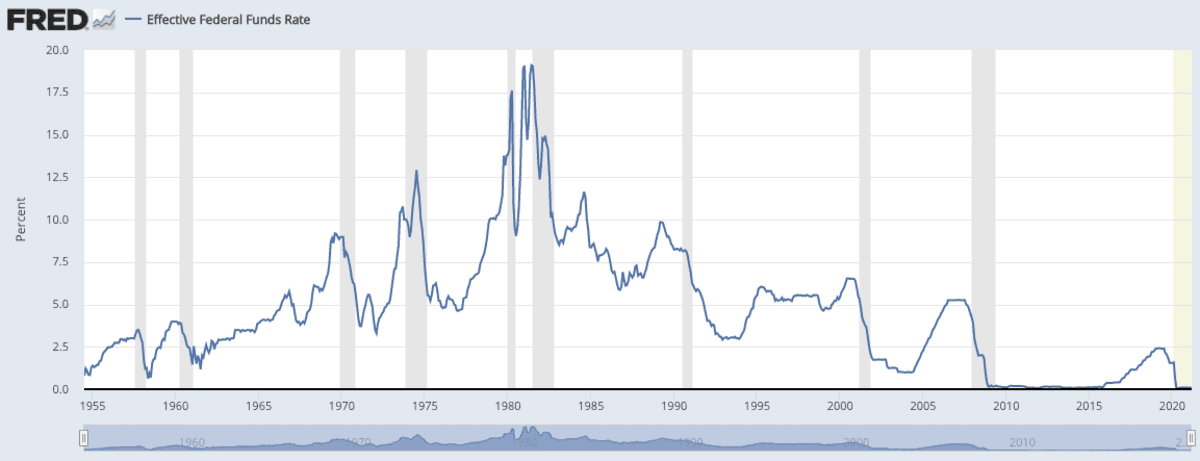
Effective Federal Funds Rate from 1955 to 2021
For the past 40 years, interest rates have been in a long-term downward trend, while the debt burden has been accumulating throughout the economic system. Each economic boom since 1981 has benefited from economic stimulus in the form of looser monetary policy.
This can be observed through the chart of the effective federal funds rate and the annual percentage change in real GDP. The long-term growth of productivity and technology stems from human entrepreneurship and ingenuity, but in the short to medium term, the credit cycle has a significant impact on economic activity.
Note that every time real GDP declines, interest rates also decrease.
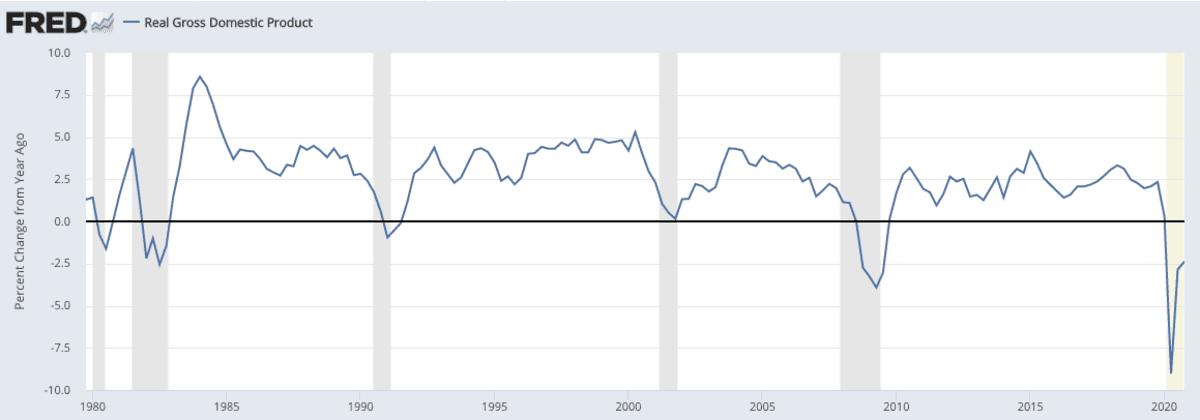
Year-on-Year Change in Real GDP from 1981 to 2021
Interest rates peaked at 19% in 1981, and the long-term trend of interest rates has been downward over the past 40 years. In other words, over the past 40 years, discounted cash flows have propelled every asset to new heights. Based on valuations supported by continuously declining interest rates, bonds, stocks, and real estate have all appreciated several orders of magnitude, and these price increases cannot be effectively measured by flawed CPI metrics. Now, with the Federal Reserve's funding rate at the zero lower bound, the method of lowering interest rates has become unsustainable.
Below are charts of the three most recent short-term debt cycles, with data on effective federal funds rates.
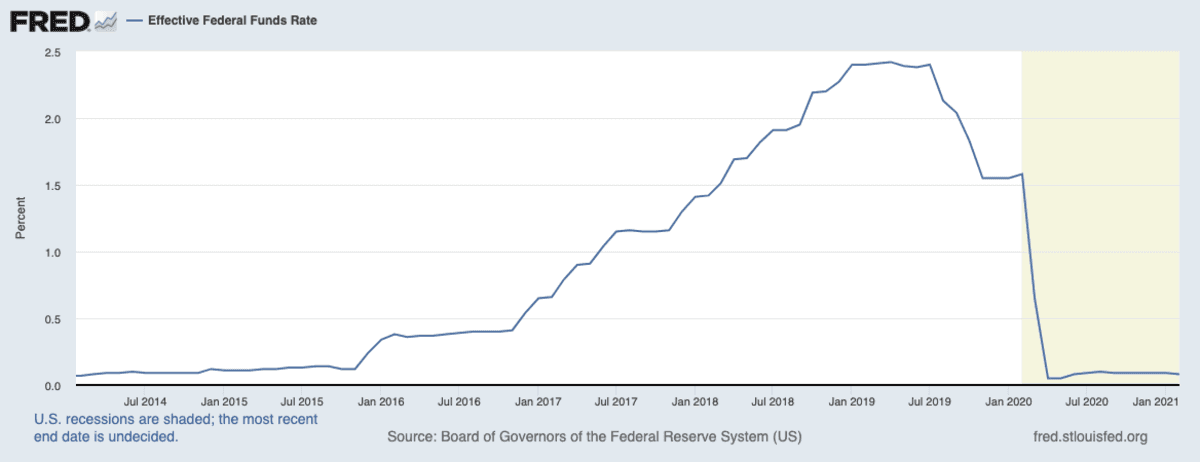
0.25%→2.25%→0.25% interest rate cycle, 2015–2020
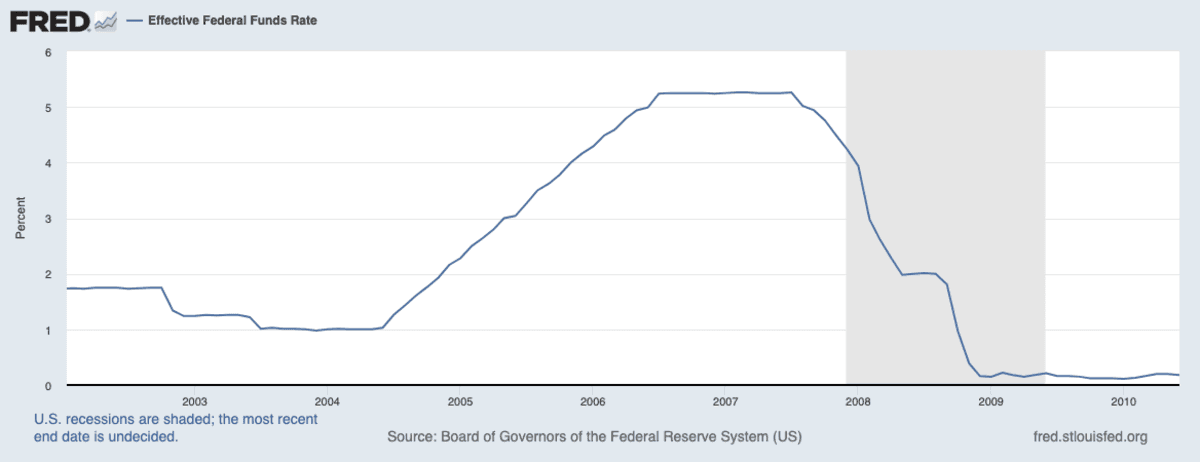
1.0% → 5.25% → 0.25% interest rate cycle, 2004–2009

3.0% → 6.5% → 1.0% interest rate cycle, 1994 –2004
Secondary Effects of Loose Monetary Policy#
The increasingly loose monetary policy over the past few decades has a side effect: significant asset price inflation. Much of the rise in asset prices is not due to increasing productivity or output but rather the massive credit expansion and lowering of discount rates that follow each subsequent “bankruptcy” or deleveraging event. Asset price inflation concentrates wealth in the hands of a few, and the secondary effect of this is social unrest and widespread polarization.
“During bubble periods, the wealth gap widens; when the less affluent face difficulties, this wealth gap becomes particularly infuriating... It is during such times that populism from both the left and right often rises. How should the public and political systems address this issue? The answer to this question is key to how the economy and society navigate this period. As shown, inequality and populism are rising in the U.S. today, just as they did in the 1930s. At that time and now, the net worth of the top 0.1% of the population is roughly equal to the total wealth of the bottom 90%.” — “Principles for Navigating Big Debt Crises”

Thus, the polarization and political divisions that have emerged in the U.S. over the past decade can be traced back to these causes. There is nothing new under the sun; looking back, we can see similar cases in history. The increasingly supported populist movements and policies that have emerged in the U.S. are predictable, as they are a natural response from the public to decades of monetary policy decisions that have harmed them. If we only focus on those specific individuals rather than the systemic inequalities created and reinforced by loose monetary policy, we miss the crux of the issue.
“In some cases, taxing the rich becomes a politically attractive policy because the wealthy have made a lot of money during economic booms—especially those in finance—and people feel that the root of the problem lies in their greed. The central bank's purchase of financial assets also disproportionately benefits the wealthy, as they hold far more of these assets. A significant leftward political shift often accelerates efforts for asset redistribution. This often prompts the wealthy to shift their wealth, including converting it into safe forms or moving it to safe places, and this behavior itself can further impact asset and currency markets.” — “Principles for Navigating Big Debt Crises”
Recently, there has been an example: Democratic Senators Elizabeth Warren and Bernie Sanders proposed a wealth tax. Unlike standard capital gains taxes, a wealth tax directly confiscates a certain percentage of a person's wealth above a certain net worth threshold. Many people across different political spectrums believe that the U.S. needs such a policy due to the “ills of capitalism.” However, ironically, the massive economic inequality and wealth inequality currently faced by the U.S. (and the world) is not a result of free-market capitalism. The large proportion of wealth held by the top 1% and the investment class is not a result of productivity growth but rather a consequence of financial engineering caused by loose monetary policy.
“Free Market Capitalism?” Not So Fast...#
Although the U.S. is often described as a “free market capitalist country,” this characterization is not entirely accurate for the following reasons:
In a free market capitalist economic system, the most important pricing mechanism is money. When there is a monopoly institution setting the price of money, the market itself is not “free.” Lowering the price of money whenever the economy declines cannot be considered free. Such policies include the recent injection of hundreds of billions of dollars, and now whenever there is a large-scale liquidation of bad investments, trillions of dollars are injected into the financial markets. This monopolistic pricing of money is part of the reason for past systemic crises and will exacerbate future inequalities. This is most clearly seen through the negative real interest rates provided by the sovereign debt market.
Time Value of Money = Negative?#

The real yield on U.S. Treasury bonds at the time of writing this article
As the Federal Reserve sets interest rates to zero while simultaneously engaging in large-scale quantitative easing to monetize the federal deficit, the “risk-free rate” upon which the financial system is based has effectively become “return-free risk.” The result is a massive surge in asset valuations, and the wealth of asset holders has grown exponentially.
Since the 2008 financial crisis, the wealth gap has widened further. The following is the S&P 500 index, which has grown nearly 500% in just 12 years under the influence of ZIRP (zero interest rate policy) and quantitative easing (QE).
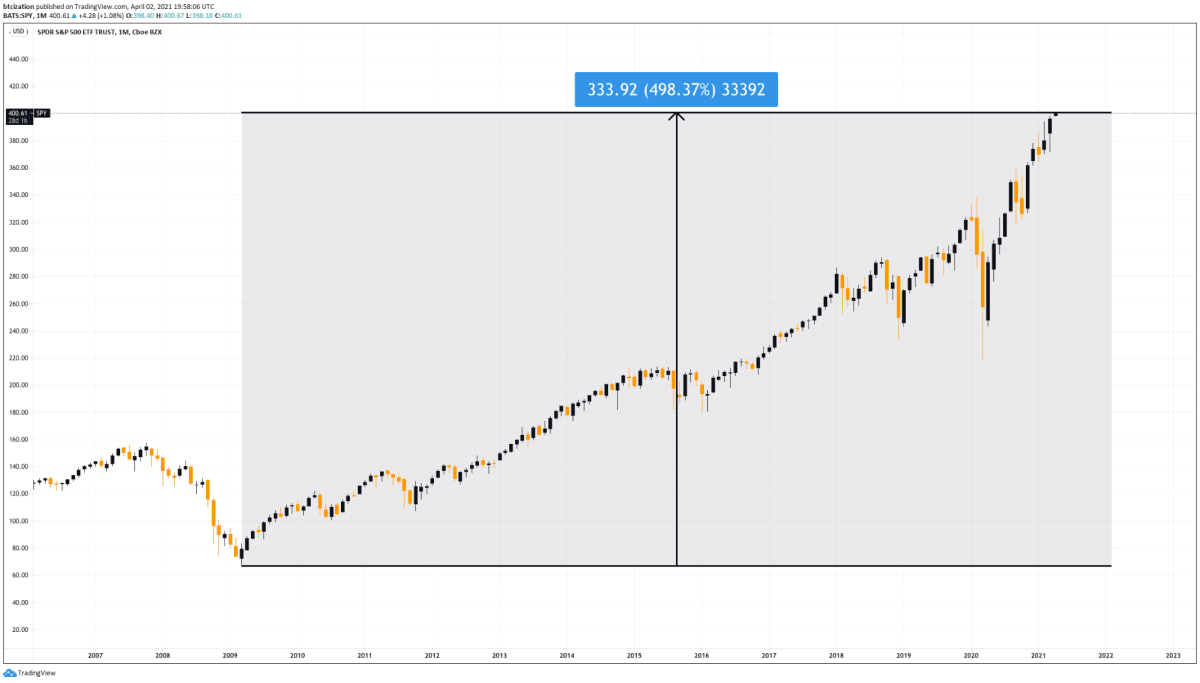
The Federal Reserve's recent “Survey of Consumer Finances” report found that the top 10% of households in the U.S. hold 84% of the stocks, while the bottom 50% hold only 1%. Just this data alone is enough to illustrate that Federal Reserve Chairman Jerome Powell's claim that the Fed's policies “absolutely do not contribute to wealth inequality” is a complete lie, merely an attempt to save face for the Fed.
What Comes Next?#
So, what will happen next? The gap between the “haves” and “have-nots” has never been so wide, and central banks have committed to keeping interest rates at 0% for a long time, while the overall debt burden of the economy is larger and more unsustainable than ever.
Mathematically, we have no way to escape the current economic environment. Policymakers know there is only one way forward, which is the same reason that caused these problems in the first place: more stimulus in the form of QE (to provide additional liquidity to the financial markets and suppress yields) and fiscal stimulus plans that drop checks and aid to the public (to minimize social unrest as much as possible).
This system is unsustainable because it requires exponential expansion of the monetary base, and monetary expansion will only exacerbate the current economic environment's problems. In such a reality, asset prices will continue to soar, and the lower and middle-income groups will find it increasingly difficult to cope, as real wage levels will decline due to the coupling of monetary policy and technological advancements (which automate many jobs that were previously held by humans). The actions currently being taken are not a long-term solution, and past data supports this.
Below is a series of charts showing various debt and income indicators since 2000. Please draw your own conclusions from this data.
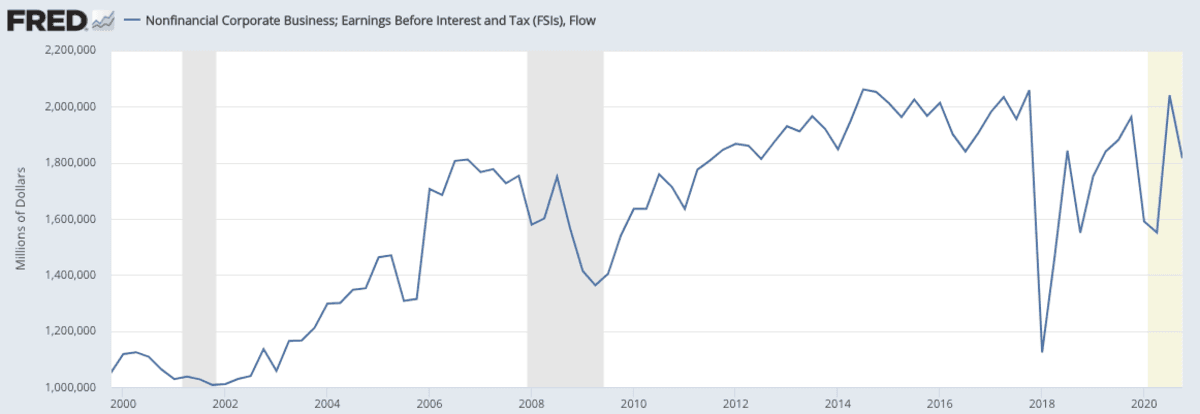
Corporate Revenue: Increased by 55% since 2000
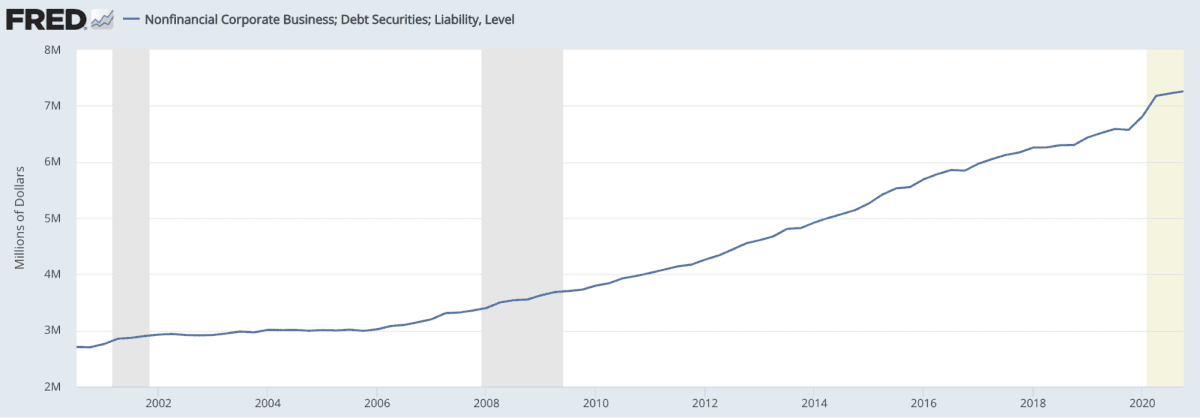
Corporate Debt: Increased by 166% since 2000

Median Household Income: Increased by 63% since 2000

Total Debt, Households and Nonprofits: Increased by 146% since 2000
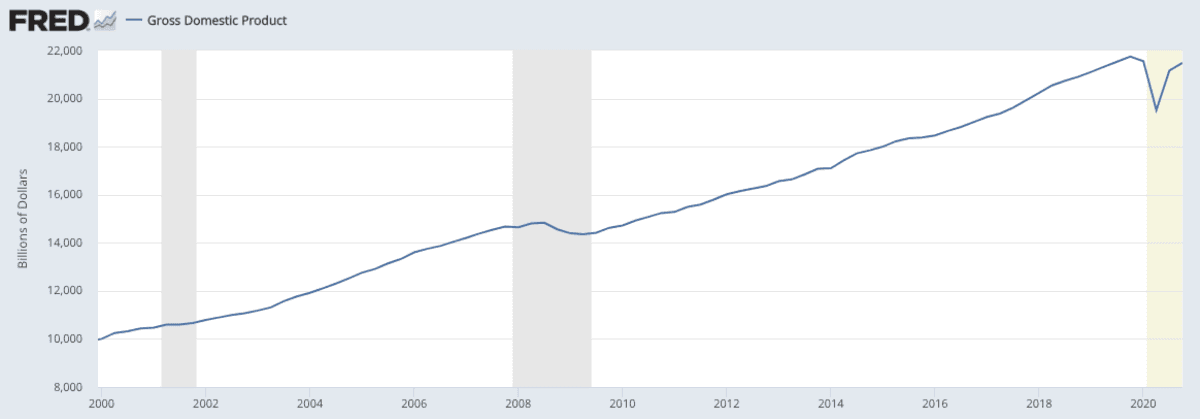
Gross Domestic Product: Increased by 115% since 2000

Debt Securities and Loans, All Sectors: Increased by 206% since 2000
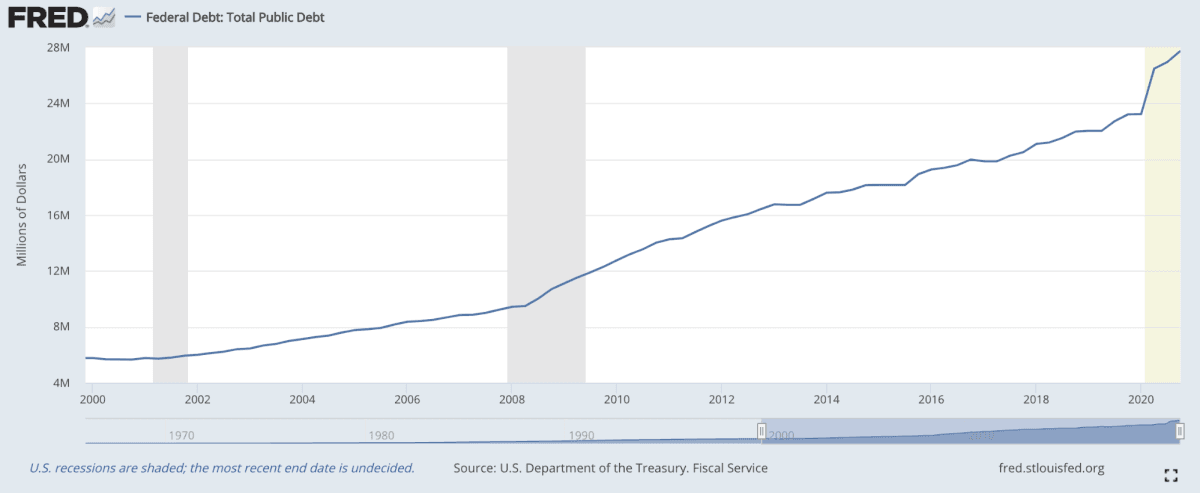
Federal Debt: Increased by 380% since 2000
Technology is Changing the Rules#
The ongoing “growth” driven by the pursuit of ever-increasing credit expansion is problematic because the rules of the game have fundamentally changed. Technology has fundamentally altered the rules of our economic system, while our monetary system struggles to adapt.
In the world we live in, rapidly advancing technology allows us to create more with less. As past jobs are automated away and technology continues to drive costs toward zero in many aspects of life, our monetary system must maintain nominal costs in a state of continuous growth. Even though technological advancements should benefit everyone, allowing all to enjoy a higher standard of living at lower real costs, the current monetary system must do everything possible to avoid deflation.
In a world experiencing exponential technological growth, exponentially more stimulus and debt are needed to hold this system together. Without the continuous growth of stimulus in the form of central bank balance sheet expansion, the debt burden built up over the past 40 years would be alleviated, debt costs would explode, and all banks would be unable to pay, leading the global economic system into a Great Depression. Remember, whether on a microeconomic or macroeconomic level, a situation where spending exceeds output can only be sustained for a limited time.
Below is a chart of the balance sheets of major global central banks. Although this article focuses on the U.S. domestic economy, this chart indicates that the phenomenon described earlier is global.

Policymakers' decisions are constrained by policies from decades ago. In this environment, their actions make sense on their own, but that does not mean such actions are the “right” or practically effective long-term solutions for the global monetary and economic system.
Human civilization has reached a turning point. In the context of technological deflation, inflationary monetary policy means that either the state will accumulate greater power in its hands, or people will voluntarily join and adopt a superior monetary system—one that cannot arbitrarily change the rules.
Solution: Bitcoin#
“At this stage of the long-term debt cycle, the effects of debt monetization are diminishing, and to compensate for this effect, policymakers sometimes increase the quantity of monetized debt. While this can provide some help, there is a tangible risk: further prolonged monetization will lead people to question whether this currency is suitable for storing value. This will cause them to start turning to other currencies, such as gold. The fundamental economic problem that most economies face at this stage is that the claimed purchasing power exceeds the actual purchasing power that can be realized.” — “Principles for Navigating Big Debt Crises”
We are now witnessing this play unfold. The global economic system is under immense debt: without continuous injections of liquidity/stimulus, a deflationary collapse will occur. With interest rates constrained at the zero lower bound and debt monetization growing exponentially, mass defaults will not occur explicitly but will happen implicitly. The erroneous item is the value of the currency (in this case, the dollar) itself. A debt jubilee will arrive, manifesting as the erasure of creditors' purchasing power.
During periods of debt monetization, the rational economic motivation is to protect one's wealth by seeking assets that will not depreciate or be “printed” (such as Bitcoin). There will only ever be 21,000,000 Bitcoins in existence. With its completely inelastic, programmatic supply issuance, every rational economic participant will view Bitcoin as a logical choice to use as a store of value, medium of exchange, and ultimately as a unit of account for all economic activities.
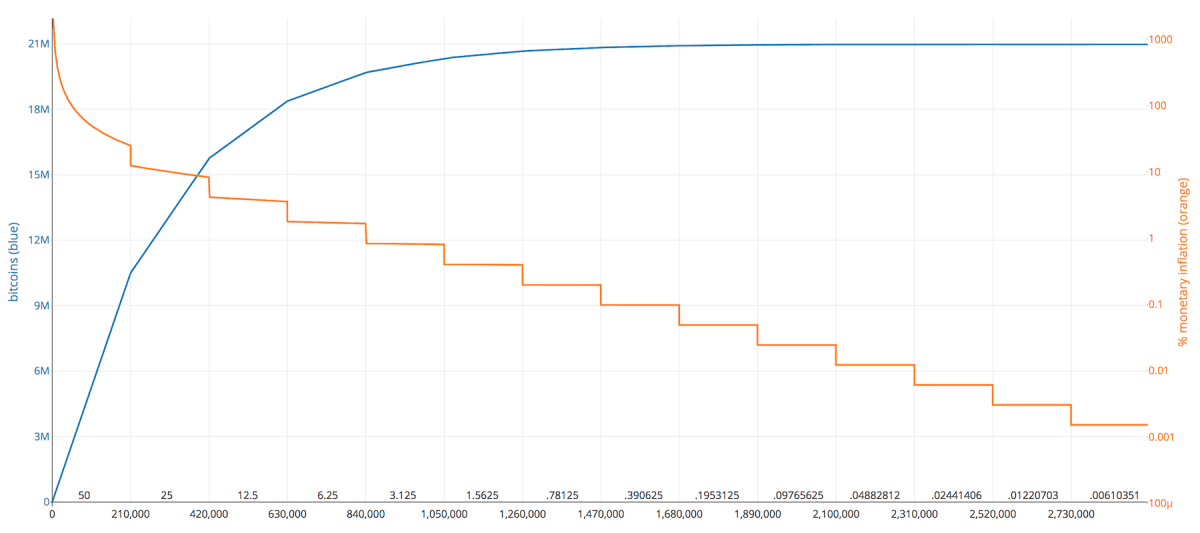
Bitcoin's Monetary Policy
“Generally, they have the motivation to move their money outside of the country (which will cause currency weakness), evade taxes, and seek safety in liquid and credit-independent investments (such as low-risk government bonds, gold, or cash). This often prompts the wealthy to shift their wealth, including converting it into safe forms or moving it to safe places, and this behavior itself can further impact asset and currency markets.” — “Principles for Navigating Big Debt Crises”
As previously mentioned, wealth taxes and increasingly ambitious taxation methods are emerging in the political arena, with politicians hoping to use them as a “solution” to bridge the wealth gap. History and economic reality do not agree: these tax policies are ineffective because the wealthy always find ways to shift their wealth outside the taxable range. Now, with the rise of Bitcoin, we have an asset that cannot be frozen and is censorship-resistant, and it exists outside of any jurisdiction. Using Bitcoin, we have the potential to store wealth in a self-sovereign manner, completely without counterparties and without credit risk. Any individual or entity facing adverse tax laws can simply protect their wealth behind this cryptographic energy wall, shielded from the predation of national governments.
The current monetary order will inevitably be disrupted. Over the past nearly century-long process, the monetary systems of the U.S. and the world have changed: a few have profited, while everyone else has paid the price. If you support humanity, you must agree: rule-based systems are superior to those determined by rule-makers. In the context of technological advancement, the world needs a compatible monetary system. The function of money is to coordinate every economic activity, and Bitcoin is the best tool humanity has ever obtained to fulfill this function. With Bitcoin, money becomes a free market phenomenon again, and human civilization will thrive and prosper as a result.
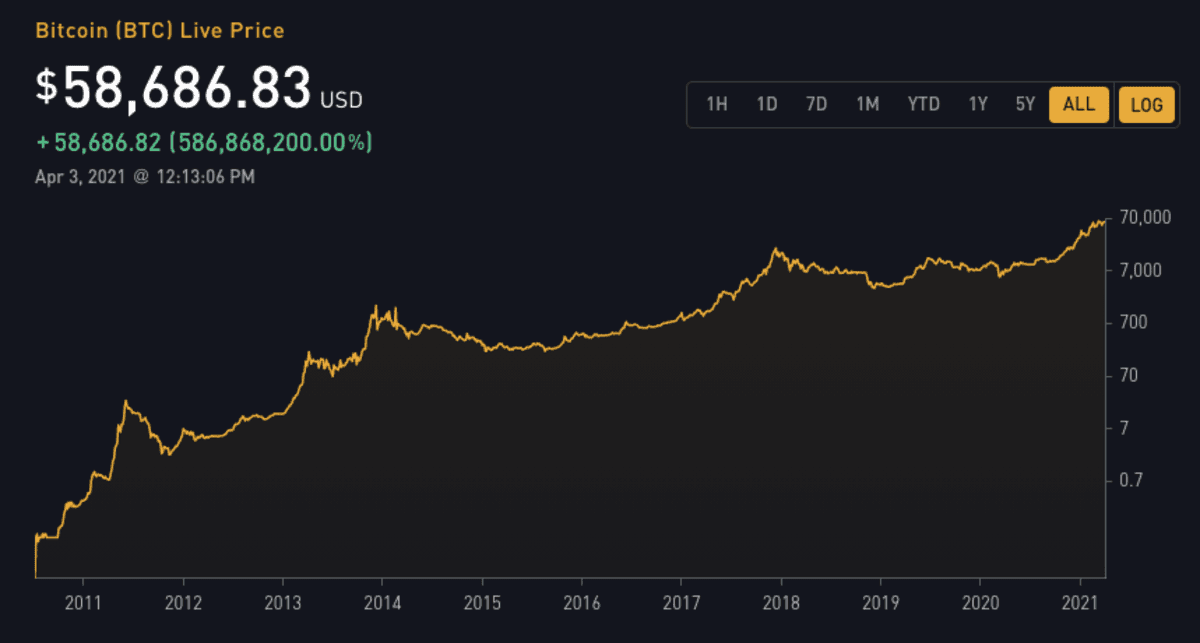
Bitcoin to Dollar Exchange Rate, Logarithmic View, Image from https://bitbo.io/
For 12 years, Bitcoin has established its global status: an alternative monetary system that anyone can freely and voluntarily adopt. Despite the endless criticisms from “economic experts” and “monetary authorities,” Bitcoin's value continues to grow exponentially.
Now, as the current monetary order self-destructs, Bitcoin stands up, and this digital currency network will provide direct incentives for everyone and every entity on this planet to use it.
A massive debt jubilee is approaching, which future generations will refer to as hyperbitcoinization.